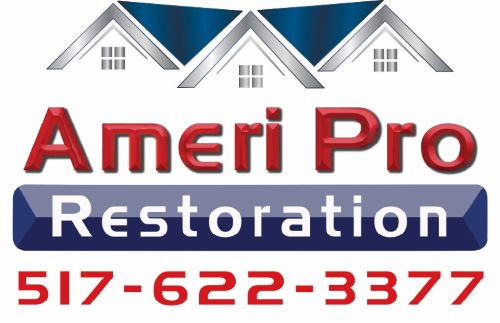Floods can severely damage homes and businesses, leading to a disturbing disruption in your daily life. There are various effects of flood damage, but it is essential to address it immediately and properly before further damage is done to your property or compromises your safety. The purpose of this guide is to outline the seven essential steps to professional flood damage restoration and explain the process professionals use to assess, clean, repair, and restore a flood-damaged property.
Path to Restoration: Seven Pro Steps After a Flood
Proper flood damage restoration is crucial for protecting both your property and your health. Knowing each step in the flood damage restoration process will ensure it is thorough, efficient, safe, and will protect your investment while providing you with peace of mind. At Ameri Pro Restoration, we follow proven professional steps to deliver reliable and comprehensive flood damage restoration services.
Keep reading to know about the 7 steps that professionals use for flood damage restoration:
Step 1: Emergency Contact and Damage Assessment
A prompt response is important, and professionals will continue to investigate the water to most likely find the source of the problem and the correct category of water, but also the overall extent of damage, to determine proper restoration plans and procedures for a safe and strategic recovery plan.
How does the inspection:
- Property safety assessment: Inspect the area for electrical and structural hazards to ensure it is safe to enter.
- Identify water source: Locate and stop the water source to prevent further flooding and damage.
Step 2: Water Extraction
This stage consists of the fast removal of standing water from the property, using powerful extraction equipment to mitigate damage and get the site dry. Fast extraction is important to prevent water from the materials from saturating deeper and to limit the potential for mold growth within the property.
That’s how professionals extract water!
- Pump out water: High-powered pumps and/or vacuums can get large amounts of water from flooded areas.
- Wet-vacuum remaining moisture: Heavy-duty vacuums can remove remaining water from carpets and surfaces.
Step 3: Drying and Dehumidification
To fully dry the building material, all moisture contained within porous materials must be removed, which leads to problems such as swelling, warping, and mold.
Learn how professionals dry out the excessive water!
- Installing Tools: Air movers and a commercial dehumidification system will be installed to properly dry out the moisture.
- Measure moisture levels: Using meters and thermal cameras, technicians will identify and monitor moisture.
Step 4: Cleaning and Sanitizing
Once the area has dried completely, but not before, all surfaces must be properly cleaned and disinfected to remove any contaminants and discourage further microbial growth. This is especially important for any properties impacted by grey or black water, as it may contain dangerous pathogens.
- Disinfect all surfaces: Antimicrobial treatments are administered to eliminate bacteria and to prevent the growth of mildew and mold.
- Cleanable salvaged items: Whenever possible, personal belongings, furniture, and other items can be cleaned and deodorized.
Step 5: Demolition and Material Removal
Unsuitable materials that sustained major damage due to floodwater, such as drywall, insulation, and carpet padding, are disposed of because they cannot be properly cleaned and restored. These items must be removed to prevent contamination and conduct proper drying of the residual materials in the structure.
- Dispose of affected contents: Once items that cannot be properly restored are removed and properly disposed of in accordance with local regulations.
- Remove wet building materials: Removing affected structural materials allows technicians to dry the wall cavities.
Step 6: Repair and Reconstruction
At this time, the property is returned to its pre-loss condition, from some minor repairs to entirely rebuilding the structure. This includes the replacement of damaged structural items and completing the final finish to re-establish the property as livable.
- Replace damaged materials: The property is returned to its pre-loss condition using new insulation, drywall, flooring, etc.
- Complete cosmetic finishing: This phase of work includes painting, re-carpeting, or anything else required for the final finishes.
Step 7: Final Inspection and Documentation
Before completion, a last evaluation is done to make sure that the job is up to professional standards and that it is recorded for the client and the insurance company. This certifies that all the work was completed to a professional standard and helps to expedite the insurance claim in case they were needed.
- Conduct final moisture check: A final moisture check will verify that the property is completely dry and safe.
- Collect insurance documentation: All documentation (photos, reports, and moisture readings) is gathered to help with the processing of insurance claims.
Conclusion
In conclusion, professional flood damage restoration is thorough and systematic to protect your property and is the quickest available means of resuming normal life. Following the seven steps outlined above — emergency contact and assessment to final inspection — ensures that you mitigate further damage, ensure safety, and submit a timely insurance claim. When you trust the restoration work to a certified professional, you are restoring your property and peace of mind during a difficult time in your life.
FAQs
- Will mold grow after a flood?
Mold can develop within 24 to 48 hours after flooding. - What items can be saved after a flood?
Many hard, non-porous materials can be cleaned and restored. - Does flood damage restoration eliminate odors?
Yes, professional cleaning and deodorizing treatments are typically included and are very effective at removing musty or unpleasant odors. - How long does flood damage restoration take?
The process can take anywhere from a few days to several weeks, depending on the severity of the damage. - Does insurance cover flood damage restoration?
Coverage depends on your policy. Many homeowners require additional flood insurance for full protection.

